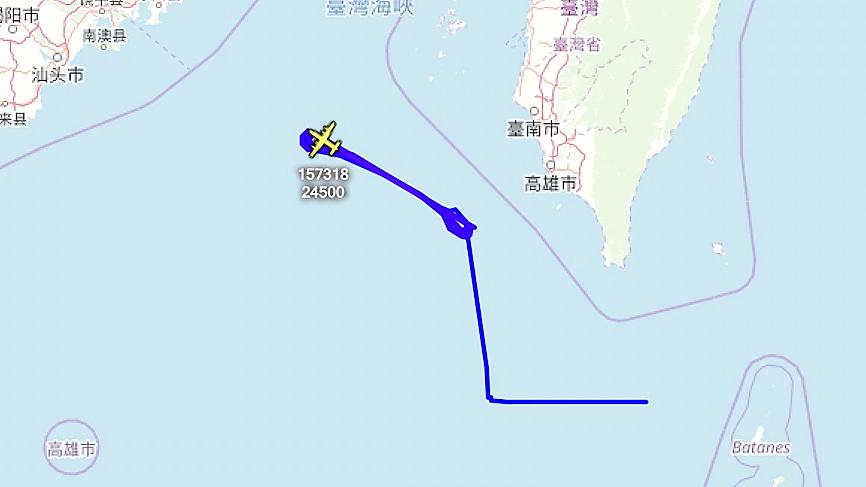A Twitter account that tracks military aircraft movements has indicated an increase in US military activity near Taiwan, coinciding with an increase in Chinese military activity in the area.
Planes from the US Seventh Fleet have been sighted frequently above the South China Sea in the past several days, and a US Navy EP-3 reconnaissance plane was seen flying close to Taiwanese airspace southwest of Kaohsiung yesterday, according to posts by the Twitter account Aircraft Spots.
The EP-3 was seen circling above the same area, Aircraft Spots said, adding that other planes from the fleet were seen in the past few days near the Philippines, where they appeared to be gathering information on Chinese vessels in the area.

Image from the Aircaft Spots Twitter account
The Ministry of National Defense said that its surveillance network is capable of monitoring the seas near Taiwan and that it always monitors the movements of aircraft and vessels near the nation’s territory.
Aircraft from the Chinese People’s Liberation Army Air Force have been spotted near Taiwan on four occasions in the past six weeks — Feb. 9, 10 and 28, and March 16.
The most recent sighting was the first time a Chinese military aircraft had approached Taiwan at night during a drill.
Following the Chinese drills on Feb. 10, a US MC-130J Commando II transport aircraft and two B-52 bombers flew over waters west and east of Taiwan.
The US last month also flew P-3 Orion maritime surveillance aircraft over waters south of Taiwan, and on Feb. 16 sailed a warship through the Taiwan Strait.

‘WIN-WIN’: The Philippines, and central and eastern European countries are important potential drone cooperation partners, Minister of Foreign Affairs Lin Chia-lung said Minister of Foreign Affairs Lin Chia-lung (林佳龍) in an interview published yesterday confirmed that there are joint ventures between Taiwan and Poland in the drone industry. Lin made the remark in an exclusive interview with the Chinese-language Liberty Times (the Taipei Times’ sister paper). The government-backed Taiwan Excellence Drone International Business Opportunities Alliance and the Polish Chamber of Unmanned Systems on Wednesday last week signed a memorandum of understanding in Poland to develop a “non-China” supply chain for drones and work together on key technologies. Asked if Taiwan prioritized Poland among central and eastern European countries in drone collaboration, Lin

The Chien Feng IV (勁蜂, Mighty Hornet) loitering munition is on track to enter flight tests next month in connection with potential adoption by Taiwanese and US armed forces, a government source said yesterday. The kamikaze drone, which boasts a range of 1,000km, debuted at the Taipei Aerospace and Defense Technology Exhibition in September, the official said on condition of anonymity. The Chungshan Institute of Science and Technology and US-based Kratos Defense jointly developed the platform by leveraging the engine and airframe of the latter’s MQM-178 Firejet target drone, they said. The uncrewed aerial vehicle is designed to utilize an artificial intelligence computer

Renewed border fighting between Thailand and Cambodia showed no signs of abating yesterday, leaving hundreds of thousands of displaced people in both countries living in strained conditions as more flooded into temporary shelters. Reporters on the Thai side of the border heard sounds of outgoing, indirect fire yesterday. About 400,000 people have been evacuated from affected areas in Thailand and about 700 schools closed while fighting was ongoing in four border provinces, said Thai Rear Admiral Surasant Kongsiri, a spokesman for the military. Cambodia evacuated more than 127,000 villagers and closed hundreds of schools, the Thai Ministry of Defense said. Thailand’s military announced that

CABINET APPROVAL: People seeking assisted reproduction must be assessed to determine whether they would be adequate parents, the planned changes say Proposed amendments to the Assisted Reproduction Act (人工生殖法) advanced yesterday by the Executive Yuan would grant married lesbian couples and single women access to legal assisted reproductive services. The proposed revisions are “based on the fundamental principle of respecting women’s reproductive autonomy,” Cabinet spokesperson Michelle Lee (李慧芝) quoted Vice Premier Cheng Li-chiun (鄭麗君), who presided over a Cabinet meeting earlier yesterday, as saying at the briefing. The draft amendment would be submitted to the legislature for review. The Ministry of Health and Welfare, which proposed the amendments, said that experts on children’s rights, gender equality, law and medicine attended cross-disciplinary meetings, adding that